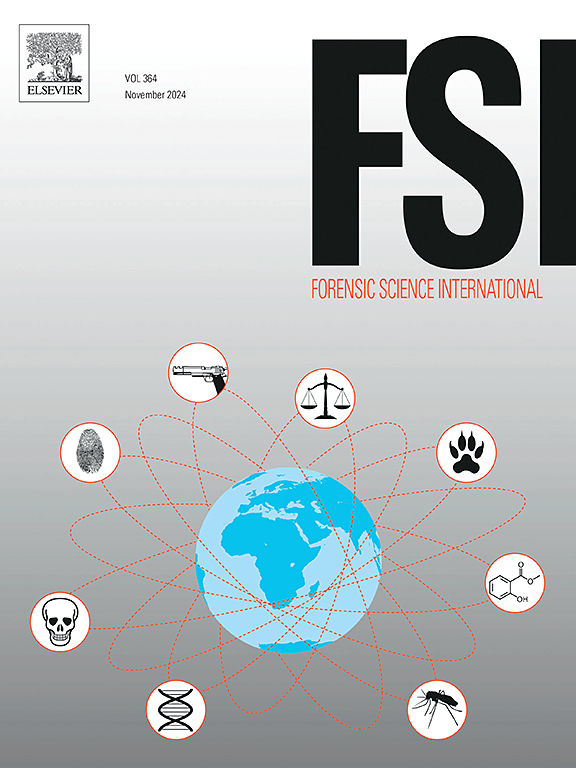The Impact of CYP2D6 metabolizer phenotypes on the EDDP/methadone metabolic ratio: A comprehensive analysis
IF 2.5
3区 医学
Q1 MEDICINE, LEGAL
引用次数: 0
Abstract
Methadone is a synthetic opioid that is often used for prevention of withdrawal symptoms and for management of chronic pain. In concentrations above the therapeutic level however, methadone can lead to detrimental side effects, such as respiratory depression. Several cytochrome P450 (CYP) enzymes are involved in methadone metabolism, foremost in building the main metabolite 2-ethylidene-1,5-dimethyl-3,3diphenylpyrrolidine (EDDP). It is well known that genetic polymorphisms within the CYPs can lead to an altered metabolism, affecting methadone elimination and peak concentrations. The metabolic ratio, in forensic toxicology suggested to assist in distinguishing between chronic and acute intake, can also be affected by genetic variations in CYP genes.
The aim of the study was therefor to examine, whether the metabolizer type of CYP2D6, CYP2C19 and CYP2B6 can be associated with a certain type of intoxication, methadone concentration or metabolic ratio in postmortem blood samples of methadone intakers.
The metabolic ratio of EDDP/methadone was determined in 37 blood samples from deceased methadone intakers in 2023. These cases were genotyped for CYP2D6, CYP2C19 and CYP2B6 via SNaPshot analysis. In case of CYP2D6 a copy number variations analysis was applied using qPCR. Metabolizer phenotypes were determined according to guidelines by the Dutch Pharmacogenetics Working Group (DPWG) and the Clinical Pharmacogenetics Implementation Consortium (CPIC).
Our results show a significantly increased metabolic ratio of EDDP/methadone in the CYP2D6 intermediate metabolizer (IM) group, compared to the CYP2D6 normal metabolizer (NM) group. Further, when separating the methadone intakers by type of intoxication, CYP2D6 IM had a significantly higher metabolic ratio in the mix intoxication and the non-intoxication group compared to NM, poor and ultrarapid metabolizers (PM, UM).
CYP2D6代谢物表型对EDDP/美沙酮代谢比率的影响:一项综合分析
美沙酮是一种合成阿片类药物,常用于预防戒断症状和治疗慢性疼痛。然而,当浓度超过治疗水平时,美沙酮会导致有害的副作用,如呼吸抑制。几种细胞色素P450 (CYP)酶参与美沙酮的代谢,主要是构建主要代谢物2-乙基-1,5-二甲基-3,3二苯基吡啶(EDDP)。众所周知,CYPs内的遗传多态性可导致代谢改变,影响美沙酮的消除和峰值浓度。在法医毒理学中,代谢比率被认为有助于区分慢性和急性摄入,也可能受到CYP基因遗传变异的影响。因此,本研究旨在探讨美沙酮服用者死后血液样本中CYP2D6、CYP2C19和CYP2B6代谢产物类型是否与某种中毒类型、美沙酮浓度或代谢比率有关。对2023年37例死亡美沙酮服用者的血液样本进行EDDP/美沙酮代谢比测定。通过SNaPshot分析对这些病例进行CYP2D6、CYP2C19和CYP2B6基因分型。对于CYP2D6,采用qPCR进行拷贝数变异分析。根据荷兰药物遗传学工作组(DPWG)和临床药物遗传学实施联盟(CPIC)的指南确定代谢物表型。我们的研究结果显示,与CYP2D6正常代谢物(NM)组相比,CYP2D6中间代谢物(IM)组EDDP/美沙酮的代谢率显著增加。此外,当将美沙酮摄入者按中毒类型分开时,CYP2D6 IM在混合中毒组和非中毒组中的代谢率明显高于NM,代谢差和超快速代谢者(PM, UM)。
本文章由计算机程序翻译,如有差异,请以英文原文为准。
求助全文
约1分钟内获得全文
求助全文
来源期刊

Forensic science international
医学-医学:法
CiteScore
5.00
自引率
9.10%
发文量
285
审稿时长
49 days
期刊介绍:
Forensic Science International is the flagship journal in the prestigious Forensic Science International family, publishing the most innovative, cutting-edge, and influential contributions across the forensic sciences. Fields include: forensic pathology and histochemistry, chemistry, biochemistry and toxicology, biology, serology, odontology, psychiatry, anthropology, digital forensics, the physical sciences, firearms, and document examination, as well as investigations of value to public health in its broadest sense, and the important marginal area where science and medicine interact with the law.
The journal publishes:
Case Reports
Commentaries
Letters to the Editor
Original Research Papers (Regular Papers)
Rapid Communications
Review Articles
Technical Notes.
 求助内容:
求助内容: 应助结果提醒方式:
应助结果提醒方式:


